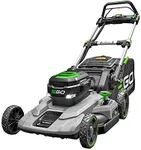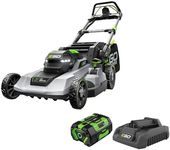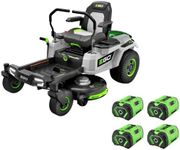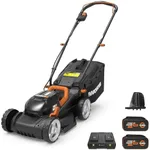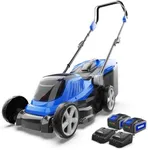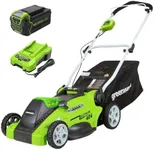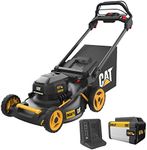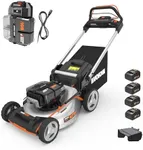Buying Guide for the Best Battery Powered Lawn Mowers
Choosing the right battery-powered lawn mower can make your lawn care routine much easier and more efficient. When selecting a lawn mower, it's important to consider several key specifications to ensure you get a model that fits your needs. Understanding these specs will help you make an informed decision and find a mower that will keep your lawn looking great with minimal effort.Battery LifeBattery life refers to how long the lawn mower can operate on a single charge. This is important because it determines how much of your lawn you can mow before needing to recharge. Battery life is typically measured in ampere-hours (Ah) or runtime in minutes. For small to medium-sized lawns, a battery life of 30-60 minutes may be sufficient. For larger lawns, look for a mower with a longer battery life or consider purchasing an additional battery. Your lawn size and mowing frequency will guide you in choosing the right battery life.
Cutting WidthCutting width is the width of the path the mower cuts in a single pass. This spec is important because it affects how many passes you'll need to make to mow your entire lawn. Cutting widths typically range from 14 to 21 inches. For smaller lawns, a narrower cutting width (14-16 inches) is usually adequate and allows for better maneuverability. For larger lawns, a wider cutting width (18-21 inches) can reduce the number of passes needed, saving you time and effort. Consider the size of your lawn and any tight spaces when choosing the cutting width.
Cutting Height AdjustmentCutting height adjustment allows you to change the height at which the mower cuts the grass. This is important for maintaining the health of your lawn, as different grass types and seasons may require different cutting heights. Most mowers offer a range of cutting heights, typically from 1 to 4 inches. Look for a mower with easy-to-use height adjustment settings, ideally with a single lever. Consider the type of grass you have and the desired lawn height when selecting a mower with the appropriate cutting height adjustment range.
WeightThe weight of the lawn mower affects how easy it is to push and maneuver, especially on uneven terrain or slopes. Lighter mowers are generally easier to handle but may have smaller batteries and cutting widths. Heavier mowers might offer more power and longer battery life but can be more challenging to maneuver. Weights can range from 30 to 60 pounds. If you have a small, flat lawn, a lighter mower may be sufficient. For larger or uneven lawns, a slightly heavier mower with more power might be a better choice. Consider your physical strength and the terrain of your lawn when choosing the weight of the mower.
Deck MaterialThe deck material of a lawn mower refers to the material used for the cutting deck, which houses the blade. This is important for durability and longevity. Common materials include plastic, steel, and aluminum. Plastic decks are lightweight and resistant to rust but may not be as durable. Steel decks are very durable and provide a solid cut but can be heavy and prone to rust. Aluminum decks offer a good balance of durability and resistance to rust but can be more expensive. Consider the typical conditions in which you'll be using the mower and how long you want it to last when choosing the deck material.
Noise LevelNoise level refers to how loud the lawn mower is during operation. This is important for your comfort and for being considerate of your neighbors. Battery-powered mowers are generally quieter than gas-powered ones, but noise levels can still vary. Noise levels are measured in decibels (dB). For a quieter experience, look for mowers with noise levels below 75 dB. If you live in a noise-sensitive area or prefer a quieter mowing experience, prioritize mowers with lower noise levels. Consider the time of day you'll be mowing and the proximity of neighbors when evaluating noise levels.
